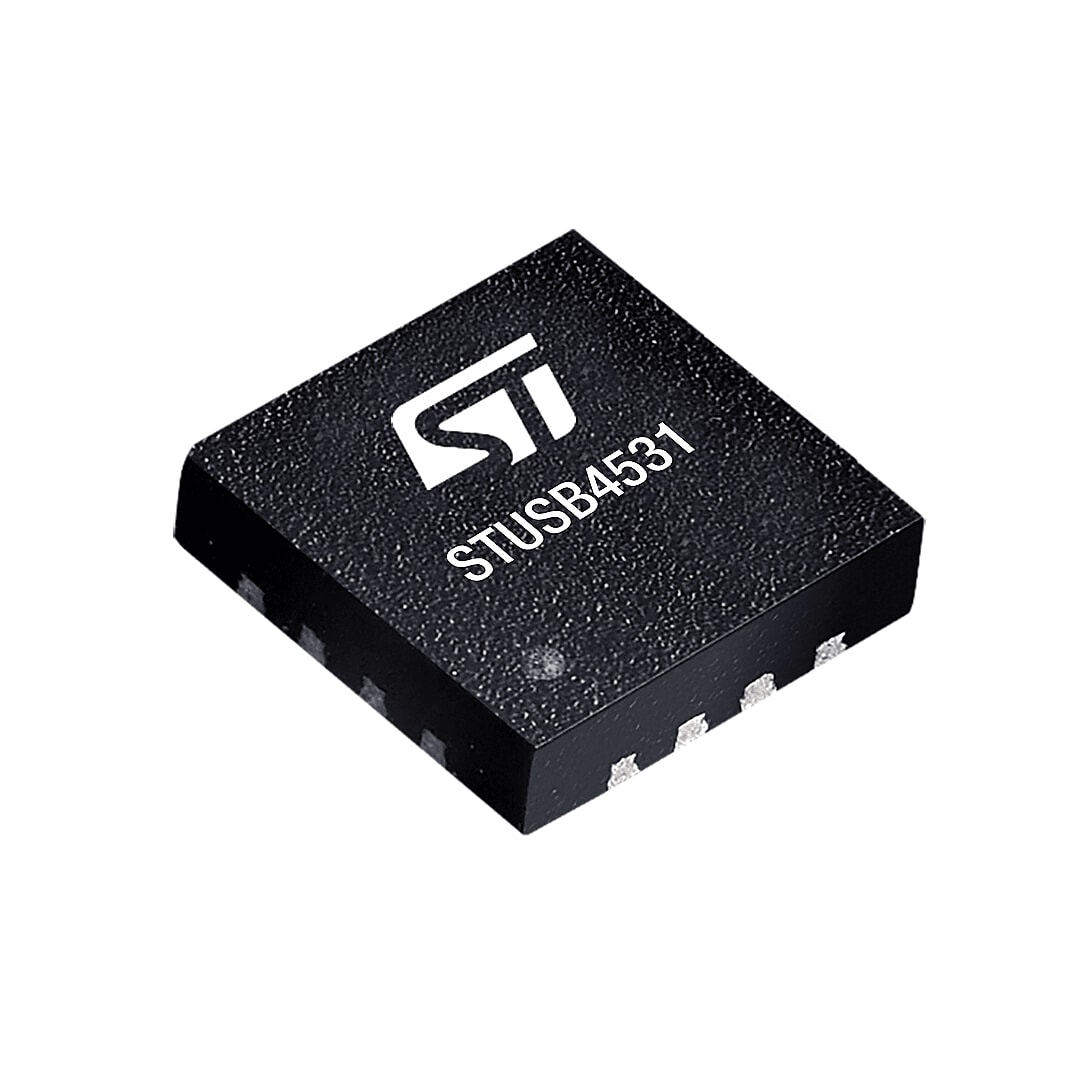One cable to rule them all
Today, an increasing number of devices and applications are adopting USB Type-C connectors for many good reasons:
- With reversible plugs, it can be plugged into a device any which way: both sides are up;
- Can carry up to 100W of charging power (from 5V/0.5A up to 20V/5.0A);
- Able to merge both legacy Type-A and -B functions in a single port and can even change roles on the fly.
New products for new applications
In addition to complying with USB I/F requirements, application-specific features are mandatory to ensure safe operation with the correct protection level, regardless of the use case.
As every USB Type-C implementation is application-specific, ST offers several reference designs to reduce development time and costs. Developers can read our Moving to USB-C, The STUSB45 and Its Reference Design in a Video blog post.
Featured Videos
Recommended for you
Simplify and optimize the power negotiation for USB Type-C® devices with the STUSB4531 standalone SINK USB PD Controller
STUSB4531 is a cutting-edge standalone USB Power Delivery (PD) sink with up to 5 configurable Sink PDO profiles (fixed, variable, PPS).
Thanks to its proprietary autorun mode for automatic power contract negotiation, it is the ideal solution for fast charging from dead battery states, also supporting both static and dynamic PDO configurations, and enabling seamless power delivery tailored to the device’s needs.
Its robust feature set and certifications make it the ideal choice for modern USB Type-C® power delivery applications demanding efficiency, safety, and compliance like battery-powered, VBUS powered, and externally powered devices, consumer electronics, IoT devices, drones, printers, 3D printers, industrial equipment, healthcare, as well as handheld devices.
The EVAL-SCS006V1 evaluation board is available to support developers in their designs.
Questions / Answers around USB-C and Power Delivery
Why USB-C connectors become more popular?
With the recent introduction of USB-C connectors supporting up to 100W of power, universal charging becomes a reality for users, especially the younger generation, seeking more portability and connectivity as well as to take care of their environmental footprint.
Why adopting USB-C as charging plug?
For devices up to 100W (20V 5A), the USB Power Delivery standard now offers a charging connector alternative to any input power plug (USB micro-B or DC barrel for instance). Main advantages and benefits are:
- Smarter design: Thanks to its thickness and robustness, the type-C connector makes the product shape smarter than with a legacy DC barrel.
- Universality: Additionally, in most cases, it makes the device compliant with universal AC adapters.
- Cost saving: For vendors, no need any longer to include in the box a dedicated AC adapter for every device.
- More convenient: For users, no need to carry multiple AC adapters when traveling. A cable works for all.
- Eco-friendly: For the planet, less electronic wastes.
For SOURCE applications (AC adapter, power hubs, etc.), please check our portfolio here.
For SINK applications (battery powered or not), please check our portfolio here.
How to migrate from micro-B port to USB-C?
ST provides developers with a comprehensive solution to help them migrate their applications from USB Type Micro-B to Type-C ports based on our standalone STUSB4500L USB Type-C port controller.
With integrated VBUS switch gate drivers (PMOS), this certified USB-C 1.4 Power Sinking Device can be supplied directly by VBUS. In this case, power is provided directly by the source, avoiding any leakage from local batteries when the USB-C port is not used.
To help developers get started with their design, our STUSB4500 evaluation board (EVAL-SCS002V1) can be used as a small footprint reference design for fast migration of any USB mini-B, micro-B or STD-B application to USB-C. Schematics and source code examples are also available.
How to migrate from custom power plug or DC barrel to USB-C?
To help with their implementation, developers can use our standalone STUSB4500 USB PD controller for power sinking devices. The STUSB4500 is tiny, safe, certified, and easily customizable. It can be powered only from VBUS, therefore not sinking any current locally, preserving the battery lifetime.
Our EVAL-SCS001V1 reference design ensures a fast and easy migration from DC barrel to Type-C ports. An STUSB4500 evaluation board (STEVAL-ISC005V1) is also available to help developers get started. Schematics and source code examples can also be downloaded.
Which countries adopted USB Type-C® as a standard charging port?
Several countries and regions have adopted or are considering adopting USB Type-C as a universal charging port with the objective of reducing electronic waste and improving consumer experience.
In Europe, the Council and the EU Parliament adopted a legislative act to make the USB Type-C charging port mandatory for various electronic devices. By December 28, 2024, portable devices such as mobile phones, tablets, e-readers, digital cameras, video game consoles, headphones, earbuds, portable loudspeakers and various computer accessories must migrate to USB Type-C charging. Laptops will follow in April 2026.
India is following the EU's lead in mandating the use of USB Type-C ports: from June 2025 onwards, all phones and tablets sold in India must have USB Type-C ports, and by the end of 2026, this requirement will extend to laptops.
In California, USA, the local legislation will require small electronic devices such as phones and laptops manufactured from 2026 onwards to be equipped with a USB Type-C charging port.
From January 1, 2025, Saudi Arabia will implement USB Type-C as the exclusive charging port for mobile phones and other electronic devices sold in the market.
Both the UK and Korea are considering adopting USB Type-C as common charging standard.




